Microdisplay Market Size
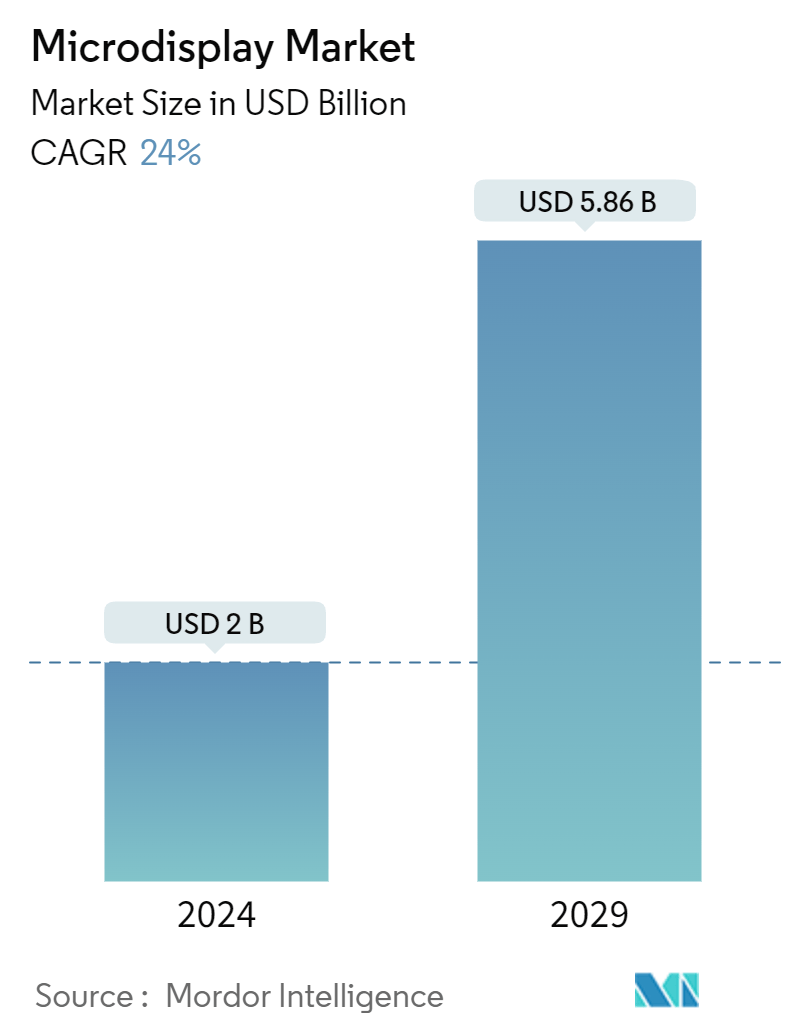
| Study Period | 2019 - 2029 |
| Market Size (2024) | USD 2 Billion |
| Market Size (2029) | USD 5.86 Billion |
| CAGR (2024 - 2029) | 24.00 % |
| Fastest Growing Market | Asia Pacific |
| Largest Market | Americas |
Major Players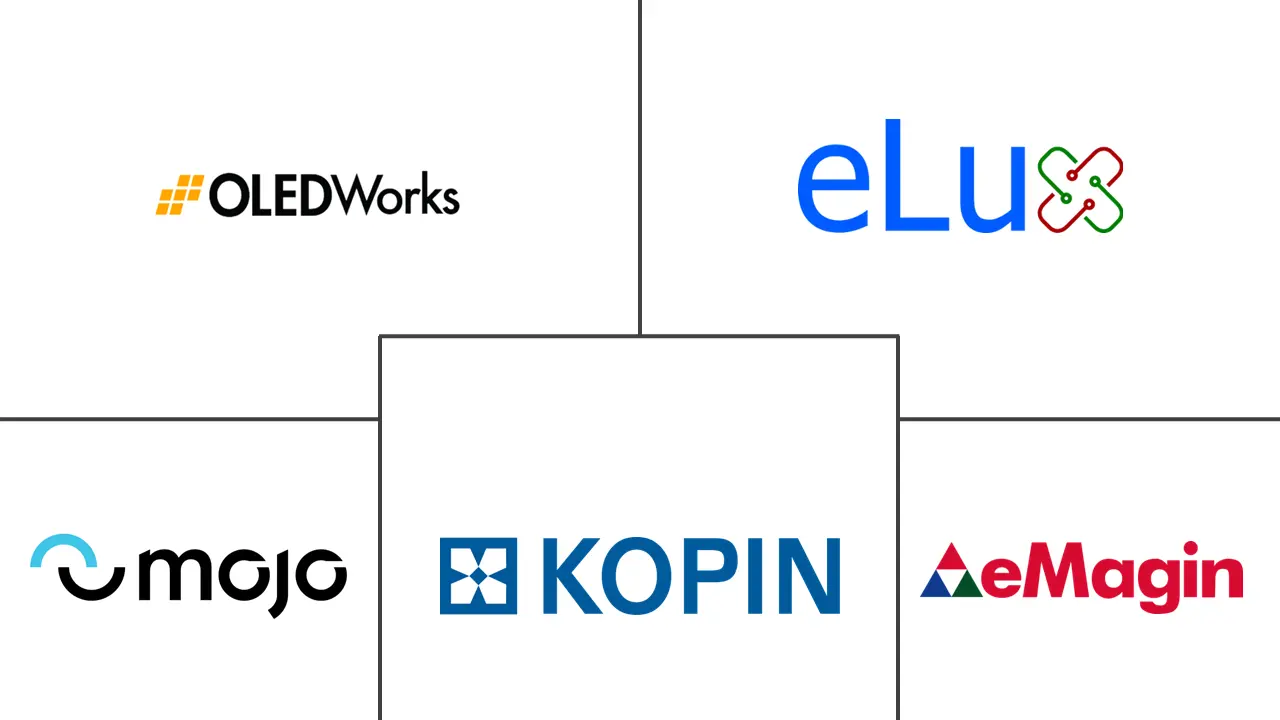
*Disclaimer: Major Players sorted in no particular order |
Microdisplay Market Analysis
The Microdisplay Market size is estimated at USD 2 billion in 2024, and is expected to reach USD 5.86 billion by 2029, growing at a CAGR of 24% during the forecast period (2024-2029).
- Modern devices are rapidly becoming compact, portable, and convenient and are used to present graphical and pictorial information. These devices must be compact and straightforward with a high-resolution display. The market for microdisplays is growing significantly as more people consider using EVFs or projectors in several sectors. Given that demand for AR smart glasses is set to increase over the next few years, microdisplays have vital growth potential.
- Microdisplays contribute to market growth for drivers and passengers by providing critical information when integrated into ADAS (advanced driver assistance systems) or autonomous vehicles. Research and development efforts are focused on manufacturing flexible and foldable microdisplays that will allow new form factors for a wide range of mobile devices and wearables.
- Most HMD systems use LCD microdisplays because they have excellent image quality and a small form factor. Magnifiers, eyepieces, or projection lenses may be used for collimating optics. A compact and light system with high image performance is always preferred for HMD systems. Technological developments in technology and immersive experiences have led to a surge in demand for head-mounted displays, especially in the gaming and entertainment sectors. Concurrently, market growth for microdisplays is driven by the increasing adoption of HMDs in health monitoring devices in healthcare, defense, and education.
- The cost of producing microdisplays can be considerable, particularly for those with advanced features such as large resolution and brightness. This may lead to reduced adoption, particularly in cost-sensitive consumer electronics applications. Microdisplays have complex production processes for the manufacture of semiconductors, requiring specialized facilities and qualified personnel. As a result, production delays and higher costs can occur, thus hindering the market's growth.
- While there have been substantial advances in microdisplays over the years, macroeconomic factors, such as several engineering issues, still exist, which prevent them from being broadly adopted for numerous challenging applications, including virtual reality head-mounted displays. The critical challenge for microdisplay manufacturers is expected to be the development of many collections that are compact in form factor and achieve a wide field of view and high resolution.
Microdisplay Market Trends
Consumer and Automotive Application to Witness Significant Growth
- The consumer electronics and automotive industry is anticipated to experience notable growth due to miniaturization in consumer electronics, the rising popularity of wearable displays, and the increasing use of ADAS in the automotive sector, particularly with HUD integration in vehicles.
- According to SIAM India, in the fiscal year 2023, India witnessed a rise in the total vehicle production volume to approximately 25.93 million units compared to the previous year. Microdisplays have attracted much attention because of their tiny size and large resolution as the primary display drivers for Augmented Reality and Virtual Reality devices. Various microdisplays, including the organic light-emitting diode (OLED) and liquid crystal display (LCD), are also used for AR/VR headsets.
- Microdisplay technologies are generally considered appropriate for Augmented Reality and Virtual Reality applications. Augmented Reality applications use microdisplay technology to add information to the user's surroundings, such as a map display in a person's glasses, a heartbeat during exercise, or a left turn signal on a racing course. Virtual Reality applications, on the other hand, consist of self-contained units that create an autonomous reality called reality within a visual apparatus. The video and gaming industries fondly use this entertainment application.
- For instance, in May 2024, VueReal, a provider of MicroSolid Printing, announced the introduction of its advanced ColourFusion microDisplay, the latest augmented reality (AR) screen that establishes a fresh benchmark in visual sharpness and color accuracy. This invention applies to both consumer electronics and automotive sectors.
- Moreover, in December 2023, Samsung Electronics assigned all OLED microdisplay projects to the Samsung Display division. At the same time, Samsung Semiconductor Inc. (SSI) and the Samsung Compound Semiconductor Solutions team will be managing the development of all Micro LED microdisplay projects. This area is mainly used in AR glasses with more advanced display needs.
- Moreover, major market players are raising investments to develop innovative products in the AR/VR segment by utilizing advanced microdisplays. For instance, in August 2023, Sony Solutions Semiconductor Corporation announced a major release of its ECX344A, the largest and highest definition 1.3-inch OLED microdisplay with 4K resolution. The new OLED microdisplays are primarily designed for virtual reality (VR) and augmented reality (AR) applications that use head-mounted displays. They deliver 4K resolution with a 1.3-type large-size display by employing miniaturization processes that SSS has achieved while developing camera electronic viewfinders (EVFs) and pixel drive circuits.
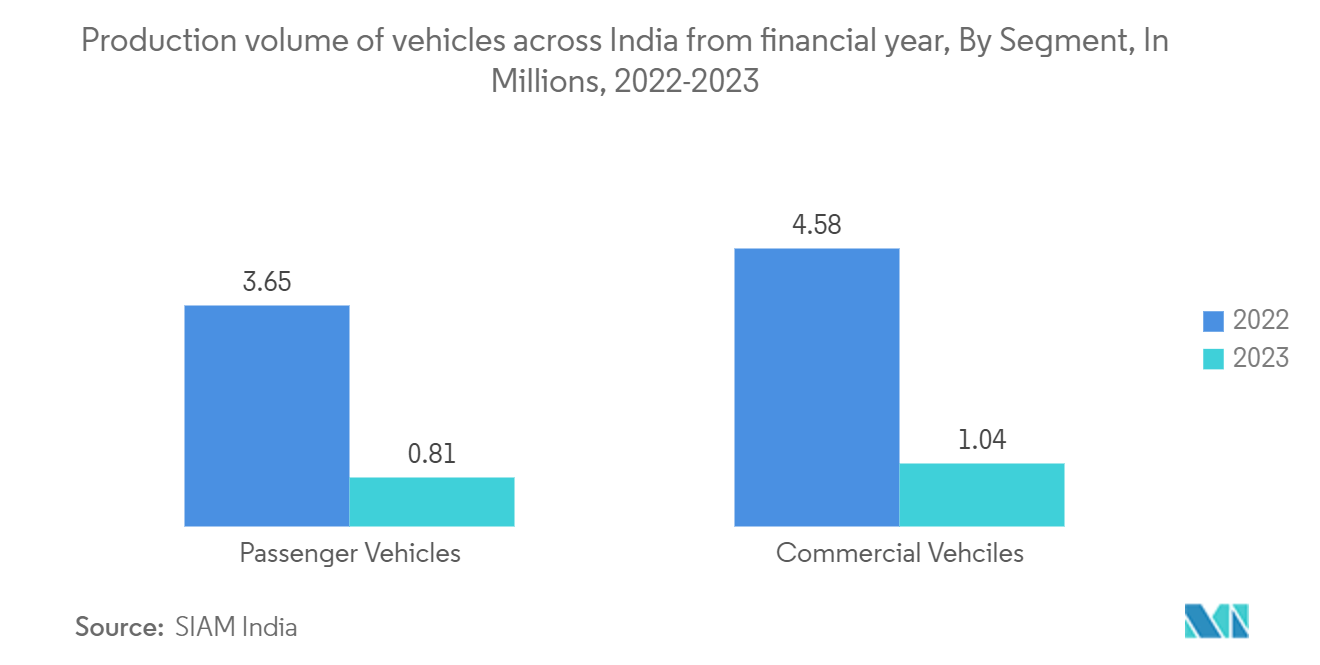
Asia-Pacific is Expected to Grow Significantly
- Asia-Pacific comprises many developing and developed countries, which are expected to contribute to the regional market’s growth. In China, different industries have shown strong growth that has given rise to the demand for microdisplays, e.g., automobiles, electronics, and healthcare. In China, Japan, South Korea, and India, the flourishing electronics industry and defense sector have been responsible for market growth in Asia-Pacific.
- The largest consumer segment in these countries is more interested in electronic devices such as smartphones, cameras, projectors, smart wearables, and remotely controlled solutions. The Asia-Pacific market for microdisplays has grown because of its fast-transforming automotive production sector. A paradigm shift has occurred within this sector regarding using HUD technologies in automobiles. In the APAC region, these changes are expected to lead to the adoption of microdisplays.
- India is driving industrial and technological adoption with its government's initiatives, such as Make in India and Digital India. This will provide a market opportunity for microdisplay producers and suppliers. Adopting AR or VR technologies for gaming, education, health care, and training is becoming more common to stimulate market growth where microdisplays are integrated into these applications.
- Furthermore, in April 2024, Kopin Corporation, a company that develops high-quality microdisplays, received its third order for producing organic light-emitting diode (OLED) microdisplays. These microdisplays are intended for use in thermal imaging systems for the Indian Armed Forces. The order includes more than 1,200 units and is expected to be delivered within the next six months. The OLED microdisplays produced by the company are known for being small in size and using energy efficiently, making the microdisplays ideal for portable thermal imaging devices that run on batteries.
- Moreover, key market players like LG Electronics, Samsung, and Sony Group have significant market shares in the region. The three world's largest display panel manufacturers, Samsung Display Company, LG Display Co., and Sony Corp., are accelerating efforts to take a leading position in the rapidly growing small organic light emitting diode screen market for virtual reality devices.
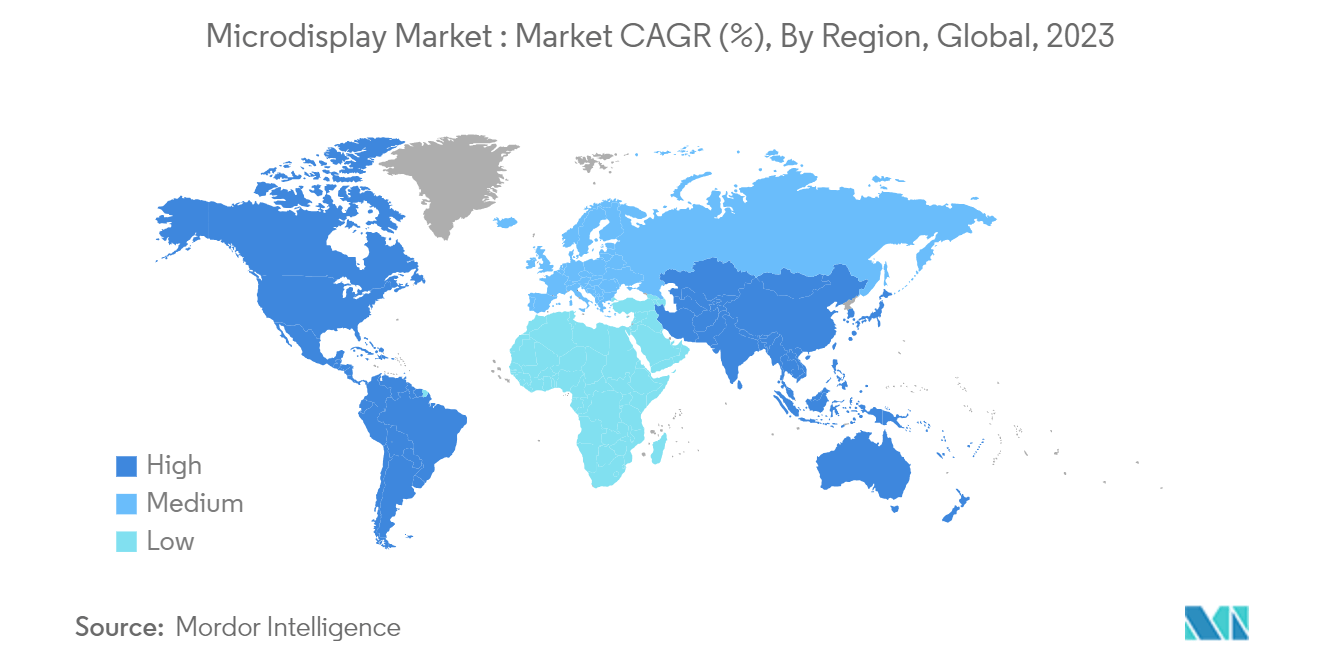
Microdisplay Industry Overview
The microdisplay market is very competitive and highly concentrated due to various large and small players. All the major players account for a significant market share and focus on expanding the global consumer base. Some significant players in the market are OLEDWorks, eLux Inc., Mojo Vision Inc., Kopin Corporation, and eMagin. Several companies are increasing their market share by forming collaborations, partnerships, and acquisitions and introducing new and innovative products to earn a competitive edge during the forecast period.
- March 2024: OLEDWorks LLC, located in Rochester, was granted an OTA (Other Transactional Agreement) worth approximately USD 8.6 million by the US government. The US Army supervises the development and enhancement of advanced OLED microdisplays for consumer and defense uses. These microdisplays are intended for head-mounted display use in the Augmented and Virtual Reality sectors.
- January 2024: Kopin Corporation and Micledi Microdisplays collaborated to create advanced microLED displays for next-generation vision solutions. The collaboration aims to design, develop, and manufacture microLED displays with a more immersive and information-rich AR experience suitable for high-brightness light conditions. MICLEDI's microLED technology, when paired with Kopin's advanced backplane design expertise, seeks to develop microLED displays that cater to the challenging requirements of new applications while addressing the limitations of existing technologies.
Microdisplay Market Leaders
-
OLEDWorks
-
eLux, Inc.
-
Mojo Vision Inc.
-
Kopin Corporation
-
eMagin
*Disclaimer: Major Players sorted in no particular order
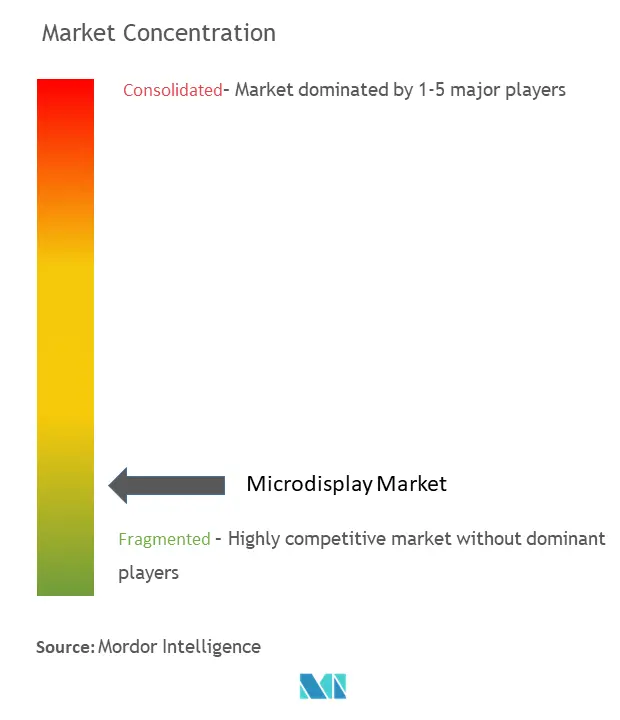
Microdisplay Market News
- February 2024: Kopin Corporation, a company that offers optical solutions designed for specific applications and high-performance micro-displays for defense, enterprise, consumer, and medical products, was granted a new contract from the Naval Air Warfare Center for Small Business Innovation Research (SBIR). This contract involves Kopin utilizing the extensive experience of over 30 years in developing micro-displays in the United States to create advanced microdisplays specially designed for lensless computational imaging.
- January 2024: Mojo Vision developed a prototype of a full-color microLED microdisplay. It combines red, green, and blue sub-pixels into one panel to create an initial full-color microdisplay. Mojo Vision utilized its high-performance QD materials and integration process for this prototype. The display prototype features 1.3 um blue LEDs. The company developed microLED microdisplay technologies specifically designed for the AR market. It developed the world's highest-density displays and smallest microLED devices, achieving up to 28,000 PPI using sub-micron LEDs.
Microdisplay Market Report - Table of Contents
1. INTRODUCTION
- 1.1 Study Assumption and Market Definition
- 1.2 Scope of the Study
2. RESEARCH METHODOLOGY
3. EXECUTIVE SUMMARY
4. MARKET INSIGHTS
- 4.1 Market Overview
-
4.2 Industry Attractiveness - Porter's Five Forces Analysis
- 4.2.1 Threat of New Entrants
- 4.2.2 Bargaining Power of Buyers/Consumers
- 4.2.3 Bargaining Power of Suppliers
- 4.2.4 Threat of Substitute Products
- 4.2.5 Intensity of Competitive Rivalry
- 4.3 Technology Snapshot
- 4.4 Impact of COVID-19 Aftereffects and Other Macroeconomic Factors on the Market
5. MARKET DYNAMICS
-
5.1 Market Drivers
- 5.1.1 Increasing Adoption of Microdisplays in Consumer Electronics and AR/VR applications
- 5.1.2 Increasing Demand for Head-Mounted Devices in Different Industries
-
5.2 Market Restraints
- 5.2.1 High Manufacturing Costs of Microdisplays
6. MARKET SEGMENTATION
-
6.1 By Type of Technology
- 6.1.1 Traditional (LCoS, LCD, DLP)
- 6.1.2 OLED-on-Si
- 6.1.3 MicroLEDs
-
6.2 By Application
- 6.2.1 Consumer & Automotive
- 6.2.1.1 Augmented Reality/Virtual Reality Headsets
- 6.2.1.2 Automotive HUDs
- 6.2.1.3 Traditional Applications (Projection/Camera, Others)
- 6.2.2 Defense
- 6.2.3 Others
-
6.3 By Geography***
- 6.3.1 North America
- 6.3.2 Europe
- 6.3.3 Asia
- 6.3.4 Australia and New Zealand
- 6.3.5 Middle East and Africa
- 6.3.6 Latin America
7. COMPETITIVE LANDSCAPE
-
7.1 Company Profiles*
- 7.1.1 OLEDWorks
- 7.1.2 eLux Inc.
- 7.1.3 Mojo Vision Inc.
- 7.1.4 Kopin Corporation
- 7.1.5 eMagin
- 7.1.6 LG Electronics
- 7.1.7 JBD (Jade Bird Display)
- 7.1.8 Sony Semiconductor Solutions Corporation
- 7.1.9 Seiko Epson Corporation
- 7.1.10 Himax Technologies Inc.
8. INVESTMENT ANALYSIS
9. FUTURE OF THE MARKET
** Subject To AvailablityMicrodisplay Industry Segmentation
For market estimation, the revenue generated from the sale of types of technology offered by different market players for a diverse range of applications is tracked. The market trends are evaluated by analyzing the investments made in product innovation, diversification, and expansion. Further, advancements in consumer and automotive defense applications are crucial in determining the growth of the market studied.
The microdisplay market is segmented by type of technology (traditional [LCOS, LCD, DLP], OLED-on-si, microLED), application (consumer and automotive [augmented reality/virtual reality headsets, automotive HUDs, traditional applications {projection/camera}], defense), and geography (North America, Europe, Asia-Pacific, Middle East and Africa, and Latin America). The market sizes and forecasts are provided regarding value (USD) for all the above segments.
| By Type of Technology | Traditional (LCoS, LCD, DLP) | |
| OLED-on-Si | ||
| MicroLEDs | ||
| By Application | Consumer & Automotive | Augmented Reality/Virtual Reality Headsets |
| Automotive HUDs | ||
| Traditional Applications (Projection/Camera, Others) | ||
| By Application | Defense | |
| Others | ||
| By Geography*** | North America | |
| Europe | ||
| Asia | ||
| Australia and New Zealand | ||
| Middle East and Africa | ||
| Latin America |
Microdisplay Market Research FAQs
How big is the Microdisplay Market?
The Microdisplay Market size is expected to reach USD 2 billion in 2024 and grow at a CAGR of 24% to reach USD 5.86 billion by 2029.
What is the current Microdisplay Market size?
In 2024, the Microdisplay Market size is expected to reach USD 2 billion.
Who are the key players in Microdisplay Market?
OLEDWorks, eLux, Inc., Mojo Vision Inc., Kopin Corporation and eMagin are the major companies operating in the Microdisplay Market.
Which is the fastest growing region in Microdisplay Market?
Asia Pacific is estimated to grow at the highest CAGR over the forecast period (2024-2029).
Which region has the biggest share in Microdisplay Market?
In 2024, the Americas accounts for the largest market share in Microdisplay Market.
What years does this Microdisplay Market cover, and what was the market size in 2023?
In 2023, the Microdisplay Market size was estimated at USD 1.52 billion. The report covers the Microdisplay Market historical market size for years: 2019, 2020, 2021, 2022 and 2023. The report also forecasts the Microdisplay Market size for years: 2024, 2025, 2026, 2027, 2028 and 2029.
Microdisplay Industry Report
Statistics for the 2024 Microdisplay market share, size and revenue growth rate, created by Mordor Intelligence™ Industry Reports. Microdisplay analysis includes a market forecast outlook for 2024 to 2029 and historical overview. Get a sample of this industry analysis as a free report PDF download.



